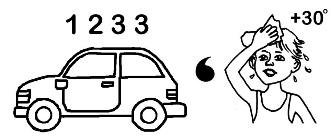Jumping right into an English lesson is
difficult for some learners. The quiet concentration necessary in an English
class differs greatly from the raucous movement that usually occurs in the
hallways. Upon arrival in class, students need to adjust to this vastly
different environment and get into the learning mode. English teachers can help
their students accomplish this goal by beginning their classes with simple warm
ups. These engaging activities allow students to ease into English and prepare
to delve into complex topics of study.
1. Board brush
Put Ss into two
groups and split the board into two halves. Write on one side A-M and on the
other N-Z. One group has to think of countries starting with one set of
letters. One student from each group comes to the board and writes a country.
They then pass the pen/chalk to the next student in their group who writes
another country. Continue until everyone has had a turn or the groups have run
out of ideas. Rub out any countries written in L1 and correct spelling of other
countries where necessary. Allow Ss to make a written record of the countries now
written on the board which will ensure that all Ss are starting at a more even
level of knowledge than they would have done without the activity.
2.Find the
similarities and differences
Put students into
pairs. Tell them to try to find five things that they have in common using the
structures: I am…(I am a boy. I am 16.Iam Polish .I am a student.) and
My…is/are(My mum is a teacher. My bag is black.)This is also a good way to
encourage peer teaching as stronger Ss will make sentences that they will have
to explain or translate for their partner. Allow 2 minutes for students to try
to find similarities, it doesn’t matter if they can’t think of five. Now join
the pairs up into groups of four. Ss now have to repeat the process but this
time using We are…or Our…is/are. Finally, elicit differences found in
open class, e.g. I’m 15. He is 16. Our mothers are teachers. Their
mothers work in a bank.
3.Throw the
questions
Ss write two
questions using the verbs to be which they could ask to other Ss in the class.
One should be an open question and one a yes/no question. If possible,
arrange Ss in a circle or at least have sitting so that they are facing as many
other Ss as possible. Nominate one student to start. They choose a second
student to ask a question to. At the same time they throw a ball or piece of
screwed up paper. The second student has to catch the ball and answer the
questions correctly. They then ask one of their questions to a different
student. Continue the activity until all Ss have asked and answered at least
one question.
4.Anagram race
This would be best
if it were done on scrap paper so that Ss had their notebooks closed. As an
alternative, ask Ss to turn to a clean page in their notebooks and tell them
not to look back at their notes. Dictate family members but as anagrams and Ss,
working alone, write down the letters as you dictate them, e.g. ioucsn (cousin)
tgaurdhe (daughter), peenhw (nephew), ceine (niece).
As soon Ss can’t refer back to their notes for this activity or it will be too
easy.
5.Journal
The most common, and most easily implemented, English class
warm-up is a journal. Teachers can easily implement journal writing by providing
students with a spiral notebook or other bound writing piece. The teacher can
place journal prompts on the board daily, or simply ask the students to write
about events that are occurring in their life at that time. To ensure that
journals are effective, teachers should set a time frame for response and
clearly communicate their length and content requirements to students.
6. Mysterious Object Descriptions
Get students into the mood to learn by challenging them. Start off
class by presenting students with an object that is not easily identifiable.
Visit your local hardware store or a rummage sale and pick up some old or
abnormal objects such as plumbing fixtures or antique machines. Ask students to
start class by describing the object in as much detail as possible and
hypothesizing a potential use for the object in question. After students have
made their guesses, show the object’s true purpose to your students.
7.Part-of-Speech Challenge
Begin class with a part-of-speech review. Copy a passage out of a
textbook or class novel and give it to students as they enter the class. Once
class begins, instruct students to highlight or circle a set part of speech in
the passage. You could, for example, ask them to circle any nouns they find.
After students have had the opportunity to seek out the assigned part of
speech, go over the answers, allowing them to mark any words that they missed.
8.Tennis
Put Ss into two
groups or, in a large class, into an even number of groups. One group starts by
saying a city, the next must return with the country that city is in and the
first group must finish the rally by saying the nationality. If there are any
err6ors or hesita66tions, the point is lost. the second group then continues
with a new city. If possible, do this in two groups so that you are able to
effectively monitor and correct.
9.Whose is it?
All Ss write down
a telephone number on two pieces of paper (the same number on each). They keep
one copy and you collect in the other. Re-distribute the numbers and make sure
no-one has their own. Ss have to find out whose number they have by mingling
and asking: Is your number …? The other student either answers Yes,
it is. or says: No, my number is… As the game goes on, Ss may
remember numbers and be able to say: No, that’s … ‘s number:
10.Board race
Put Ss into two
groups. Choose one person from each group and read out a phrase from the
previous lesson. Ss must decide whether it should take in, on or at.
The first person to write the correct word on the board, wins a point. The two
Ss then change places with another student from their group for the next turn.
Examples:
(at) a party,
school, home, a barbecue
(on) holiday, my
left, my right
(in) the garden,
the middle, the photo, a classroom
11. I’m sorry, I
have a cold
Ss write down one
question asking permission to do something. Put Ss into groups of five or six.
Each student in turn has to mime their question because they have a bad cold
and have lost their voice. When the other Ss have guessed, the next student
acts out their question. Monitor and check that Ss are using grammatically
correct English when guessing what the question is. When finished, elicit some
of the most interesting questions in open class.
12.Mixed up
messages
Write a postcard
on the board as below:
Dear
(1)____________________,
We are staying in
(2)____________. It is a/an
(3)_____________city
and the weather is
(4)_____________.
This morning we went to
(5)_____________and
(6)______________,
Tomorrow we are
going to (7) ______________.
Lots of love…
Put Ss into six
groups and number them 1-6, to correspond to the numbers on a dice. Each group
has to think of a word or phrase that could go into each gap (tell Ss that
number 6 should be an activity not another place).
When Ss are ready,
they choose one student from their group. The student from group 1 comes to the
front and reads the postcard on the board. When they get to a gap, they throw a
dice and, depending what number is shown, they ask the corresponding group for
their word and write this in correct place on the board. This may lead to some
strange postcards, e.g. We are staying in Rome .Yesterday we went to
Buckingham Palace and saw the animals. Repeat the process with a student
from the others groups.
13. Stop!
Put Ss into pairs.
Tell Ss that you are going to give them some tasks and, as soon as they have
completed them, they should shout stop! If they have got the correct
answer, they win a point, e.g. Name two things you can travel by beginning with
the letter “C”. Ss shout stop! as soon as they can think of these.
Elicit the answers and then give the next task: Name four places where you
can stay on holidays. Name three things you would pack for a camping holiday.
14. Define and
predict.
Have these words
written on individual slips of paper: climate, weather; hotter; drier; cleaner;
bigger; air pollution, water pollution, energy, plants, grow, population,
survive, endangered. Ss work in seven groups and each group has two words which
they have to think of definitions for. Ss should have an English monolingual
dictionary to help them if possible. When ready, Ss form new groups of seven so
that one person from each of the original groups is now in a game together. Ss
take it in turns to define their words and the other Ss have to guess what the
words is. When finished, Ss work together in their groups of seven to try to
guess what the lesson will be about and what each of the words will refer to,
e.g. We think it will be about the environment. Hotter – the world is
getting hotter because of global warming. Elicit ideas and then allow Ss to
open their books to check.
15 .Optimist or
pessimist?
Dictate some questions
to Ss who work alone to write their predictions, e.g. How much money do you
think you will earn? How long will the Earth survive? What mark
out of 100 will you get in your next English exam? What age will you get
married?
Either as a whole
class or, if numbers are too large, in smaller groups, Ss have to ask each
other these questions and stand in order according to how they answered them,
i.e. they start with the question about money and have to order themselves from
the most optimistic (the person who thinks they will earn the most) to the most
pessimistic (the person who thinks they will earn the least). When they are
ready, ask Ss how much they think they willearn and what jobs they think they
will have. It is meant to be a light-hearted activity so don’t worry if their
answers aren’t entirely serious. Repeat the process with the other questions.
16.Mutual
dictation.
Tell Ss to draw a
simple map of their country and, at each compass point (N, S, E, W, NE, NW, SE,
SW) to draw a symbol representing the weather in that area. Ss should try to
use a variety of weather types, even if it is highly unrealistic. Ss then draw
a second, empty map and join up pairs. One student dictates the weather in
their country and the other tries to draw the correct symbols in the correct
places on their empty map. When finished, Ss swap roles and finally compare
what the drew with the original pictures.
17. Nonsense poem.
Tell Ss you are
going to read them two lines of poetry which contain several made up words. Ss
must try to work out what part of speech they are. Dictate the words, brillig,
slithy, tove, gyre, gimble, wabe. Read the poem and elicit the parts of speech:
Twas (it was) brilling (adj) and the slithy (adj) toves (n) did gyre (v) and
gimble (v) in the wabe (n). Now tell Ss close their eyes while you read the
poem again. They should try to get a picture in their minds of what the words
mean. Ss then discuss their ideas in groups of four and finally in open class.
(this poemis from Alice in Wonderland by Lewis Carroll.)
18. Random
connections.
Ss need about
three small pieces of paper each. On these they write a country, city, river,
mountain or place in city, e.g. street, one word on each piece of paper . Once
Ss have done this, collect them all in. On the board, write on/in/of. Now put
Ss into groups of 4-5. One group choose one of the three words. Pick o8ut a
piece of paper at random and read it to Ss. They have to make a true sentence
about the place you read out using the preposition they have chosen, e.g. if
they chose in and the place in London, they could say London is in England.
If they chose on they might say London is on the River Thames. If
they chose of they could say London is in the southeast of England. If
other groups think the sentence is grammatically or factually false, they can
try to correct it. Repeat the process with the other groups in turn.
19. What did I
say?
Tell Ss you are
going to dictate some sentences to them. They should finish the sentences so
that they are true for them, noting down only their own word or phrase not what
you read out. Make short pauses between the sentences to let Ss make up their
mind.
If I leave my
country, I will move to … I get annoyed about …I hate waiting for…Our school
suffers from … When I go out, people sometimes stare at… I hope doctors find a
cure for … On holiday, I made friends with …
Ss compare answers
in groups of four, then try to recreate what you read out. Elicit full sentences
and check the prepositions.
20. Sales pitch
Elicit five of the
best places to visit in the Ss own country. These could be cities, seaside
resorts, mountain resorts, etc. Now split the class into five groups and give
each group one of the five places. Each group has to prepare a presentation to
show that their place is the best place to spend a holiday. Remind them structures:
It’s really peaceful/dramatic. What I like about it is
the natural beauty. It’s the kind of place where you can relax. It’s
the most unspoilt place I’ve ever been to. When finished, each group in
turn comes to the front of the class and Ss vote on which place (apart from
their own) sounded the most attractive.
21. Onion ring (if space allows,
otherwise, a traditional mingling)
Tell Ss to write
one question on any aspect of sport that they like, e.g. Do you like
watching the Olympics? Do you play for a team? Do you like playing sports at
school? How often do you go cycling? In an onion ring, Ss stand in two
circles, one inside the other. Each person in the inner circles faces one
student in the outer circle. Ss ask and answer each other’s questions and then
Ss in the inside circle move round one place each. Those on the outside stay
where they are so that Ss are now facing a different student. Ss ask and
answer again and the process is repeated until Ss on the inside have returned
to their starting point.
22. Board
pelmanism
This requires you
to make two sets of words on card, big enough to be seen by everyone in the
room. One set should be nine Past Simple forms and the other should be the
corresponding nine Past Participles. Example words: saw, gave, took, did,
knew, forgot, drank, ate, began; seen, given, taken, done, known, forgotten,
drunk, eaten, begun.
Stick these to the
board, with the words hidden, in two sets of three columns and three rows,
the Past Simple forms on the left and the Past Participles on the right. Ss
work in two groups. The first group chooses one word from group 1 and one from
group 2(e.g. row 2, column 1 and row 3 column 2). Turn these over so that Ss
can see the two words. If they are from the same verb, give them tj the group
who guessed them. If not, turn them back so that the words are hidden again.
The idea is for Ss to remember where words are and make pairs so the group
which concentrates hardest has the best chance of winning. When Ss have found
all nine pairs, see who won, collect in the pieces of card and re-elicit all
nine verbs, past forms and Past Participles.
23. Draw it!
Tell Ss they have
2 minutes to draw a picture. It can be of anything they like but there must be
people in it and as many activities as they can show in 2 minutes .The
pictures should not be drawn very carefully, simple stick figures will
suffice. After 2 minutes, put students into pairs, making sure they haven’t
seen each others pictures. One student covers their picture and takes a clean
piece of paper. The other describes their picture and the first student has to
draw what is described. When finished the Ss swap roles and finally show each
other their pictures to see how well they were able to draw from the
description given.
24. Parts of
speech
Dictate sentences
to Ss and ask them to say what part of speech certain words are. Ss work in
small groups and put their hands up as soon as they know. Award a point for
each correct answer. Example sentences: They create (v) (a lot
of problems. He is famous for his creativity (n). Prices in the shops
have been reduced (v). The reduction (n) wasn’t very big. He is a
researcher (n). I’m very annoyed (adj). It’s not terrible but
it’s an annoyance (n). We didn’t expect (v) to see you so soon.
He didn’t live up to our expectations (n). There have been a lot of improvements
(n) lately. The city is improving (v) all the time.
25. How many?
Ask a Present
Perfect question using have you ever … which is interesting and unusual
but which may also be answered yes by some Ss and no by others. Have
you ever ridden a camel? Now put Ss into two groups. Each group must think
of five similar questions. When they have thought of the five questions, they decide
together how many of the other group they think will say yes to each
question. They give you the five questions written down with their guess next
to each one. Read out the questions and Ss raise their hands if they have done
the things asked about. Make a note of the actual number saying yes and
tell Ss whose guesses were the closest.
26. Anonymous advice
Each student
thinks of a question to ask for a suggestion, e.g. about holidays, study,
clothes. They write this on a piece of paper. Collect them all in and
redistribute so that Ss don’t know whose question they have. If Ss have their
own question, you should change it with someone else’s. Ss now write a
suggestion in response to the question written. Collect them in again and
redistribute once more. Ss add a second suggestion. Finally, place the papers
on a desk and allow Ss to come and find theirs and read what the suggestions
were.
27. Crazy signs
Talk to students
about street signs that show what you must do(e.g. Stop), those that tell you
what you mustn’t do(e.g. a speed limit sign means you mustn’t go faster) and
those that tell you what should or shouldn’t do(e.g. a bumpy road sign means
that you should drive more slowly).
Now put the
students into groups of 4-5.Each group chooses a different place, e.g. school,
swimming pool, cinema .The groups draw four signs that don’t actually exist but
could be used in their place, e. g .No singing in class. The four signs
must represent must, mustn’t, should, shouldn’t. When finished, groups
swap papers and try to work out what the four signs represent. They write four
sentences and then hand these back to original group to see if they are correct
in their guesses or not. Elicit some of the rules and advice in open class.
28. What is the
verb?
Put the students
into six groups. Give each group a verb/verbs on a slip of paper: turn
on/off, put on/take off, down load, print out, put in/take out, click on. Make
sure that no other groups know what verb they have. Each group must think of as
many nouns as possible that their verb(s) could collocate with. Each group then
reads out their nouns, one at a time, and the other groups have to guess what
the verb is.
However, the other
groups only have one guess each so must decide whether to guess early or wait
and risk another group guessing first.
29.That’s not
mine!
Collect a pen from
each person in the class and place them on a desk, preferably in the centre of
the room where everyone can see them.
Nominate one
student to come to the desk. Pick up a pen (not that student’s) and ask: Is
this yours? Elicit the answer: No, mine is …(plus a comparative
form) newer/cleaner/ darker. Whatever they answer, choose a pen which
could be theirs and ask again. The student either replies: Yes, it is.
or they must give another comparative sentence but using a different
comparative adjective. Keep going until the student has his/her pen .That
student now nominates a second student to come to the front .The first student
plays your role, the new student has to make comparative sentences to identify
their pen. Keep going until all the pens have been returned or you think that
enough practice has been had.
30. Alien game.
Tell Ss you are an
alien from a different planet. You speak very good English but don’t know much
about the Earth. Start by introducing yourself and elicit from Ss that they
should ask if they can help: Hello, can I help you? Say yes and
ask Ss about a simple thing, e.g. What is a school? Ss give a definition and,
whatever they answer (e.g. It’s a place where students go to learn.) ask: What
do you mean by…( e.g. students)? The class give a new definition
and, again, ask question using: What do you mean by…? Next time,
deliberately mishear the students and ask: I’m sorry, did you say…? Finally,
tell Ss that should offer to do something to make it easier to understand, e.g.
Shall I take you to my school? I can take you to my school if you like.
Re-elicit the
questions you asked and they asked and put Ss into pairs to do the same
thing with a different noun. Finally, nominate one pair to act out their
conversation in open class.
Looking for a nice warm-up activity to introduce some vocabulary and get your students talking in English? Try out some samples.
Make the most words
Write a topical vocabulary item on the board. In twos or threes, students make as many new words from it as they can. Use longish seed words such as apologise, dictionary or September. Score teams a point per word and award a bonus point for the longest.
Make the longest words
Write a topical target word vertically down the board, for example, WINTER. In twos or threes, students attempt to come up with the longest word that begins with each letter. Give teams a point per word and a bonus point for the longest.
Waterfall Industrious Nausea Terrified Empty Retailer
What does your name mean?
Using a dictionary, google or any other resource, students find and write down an appropriate adjective that begins with each letter of their first name. For example:
Flirtatious, Relaxed, Extrovert, Desirable
Mixed-up sentence
Write a sentence on the board but mix up the word order, then challenge students to reconstruct the original sentence. For example:
morning hadn’t eaten wish that döner kebab I at this 5am
Mixed-up sentence (anagram variation)
Write a sentence on the board but this time scramble the letters of each word. For example:
hwy ddint’ I dusty draher ta vieyunrsit?
What do you know about bananas?
Set a five-minute time limit and in groups have students think up and write down as many facts as they can about bananas (or cats, Belgium, David Beckham, etc.). One point should be given for each true sentence.
How many sounds can you hear?
Students sit in silence for two minutes and write down every sound that they hear. Let them compare their lists with their neighbours before seeing who has the longest list?
The A to Z game
Give students a theme, for example, jobs, things you take on holiday, food. Write the letters A to Z on the board. Teams of students must race to write an appropriate word next to each letter on the board.
Things to do with a potato
Produce a potato (if that’s not possible, introduce the concept of a potato). Ask students to come up with a list of as many unconventional uses for it as they can. For example paperweight, weapon, pen holder, smartphone dock. The longest list wins the potato.
Odd one out
Give the students a couple of examples to guess, then get students to come up with their own ideas. Here are some examples:
apple, peach, banana, tomato – a banana doesn’t have seeds strawberry, branch, bowling ball, boat, iceberg – bowling balls don’t float window, river, envelope, client, oregano – client doesn’t begin and end with the same letter comb, champagne, knife, plum – the word plum doesn’t contain any silent letters
Note: There can be more than one correct answer
Name ten
Have students think of 10 items that fit particular criteria. For example:
- Jobs where you have to wear a uniform
- English football clubs
- Sports that are played with a ball
- Foods that contain egg
- Animals that lay eggs
- Three letter parts of the body – eye, arm, leg, hip, ear, toe jaw, rib, lip, gum
Two truths and a lie
An ESL classroom staple. Write or dictate three sentences about yourself. Two statements should be true and one false, for example:
I used to be an air steward I can ride a unicycle My favourite food is sushi
Now invite students to discuss in pairs which statement they think is the lie. Ask each pair which statement they think is untrue and have them explain why. Reveal your answer, and ask students to come up with three sentences about themselves. I find students need quite a lot of time (at least five minutes) to come up with three ideas. If some students are still short of a sentence or two, start the game anyway, and they can finish their statements during play. Check students’ statements and then have them take it in turns to read them out to the class. In each case, the other students have to guess which is the untrue statement.
Mastermind (AKA Bulls & Cows, Jotto)
Based on the code-breaking board game where players have to deduce the order of 4 coloured pegs which the other player had hidden behind a plastic guard. It’s slightly complicated to grasp but fun when you get the hang of it.
Think of a four letter word and write XXXX on the board, each X represents one of the letters of your word.
Invite the first student to guess what the word is.
Start a new line underneath your original XXXX. If the first letter in the student’s word is the same as the first letter in your word put a ✓ in the first position. If the first letter is not the same as the first letter in your word but is contained somewhere in your word put a half-tick /. If the first letter of the student’s word is not contained anywhere your word put an X.
In the following example, the teacher chooses the word FIRE.
XXXX XXXX – COAT X/XX – BEST X✓X✓ – HIKE /✓X✓ – RIDE ✓✓✓✓ – FIRE
A word of warning. Stick to 4 or 5 letter words. It’s much more difficult to guess longer words and it can also be tricky trying to mark each guess.
When students are familiar with the game you can get them to come and put their own words on the board.
I’m going on a picnic and I’m taking a …
This is a guess the rule type game. Think of a rule which governs which items can be taken on a picnic, for example, it must be six letters long, or it must start with a vowel. In this example, the rule is that the word must be an uncountable noun.
Teacher: I’m going on a picnic and I’m taking milk. Student A: I’m going on a picnic and I’m taking eggs. Teacher: No, you can’t take eggs. Student B: Can I take orange juice? Teacher: Yes, you can take orange juice. Etc.
Continue until students guess the rule. If they’re not making any progress, continue to add further items you would take e.g. love, information, air (the choices don’t have to make sense within the picnic scenario). Invite the students alone or in pairs to come up with their own rules and let them run the game.
Find more:
Engaging ESL Warm-ups and Fillers: Over 30 Creative Ways to Kickstart Your Class
Государственное бюджетное общеобразовательное учреждение
Республики Крым
«Евпаторийская санаторная школа-интернат»
Доклад
«Использование “warming—up activities” – залог успеха современного урока?!
Подготовила
учитель английского языка
Т.Г.Новикова
«Учиться надо так, чтобы получать удовольствие» — эти слова являются важным педагогическим принципом обучения английскому языку в школе, а для детей — их основным девизом учения. Любая деятельность должна быть мотивирующей, наполненной смыслом, приносящей удовольствие от проделанной работы, иначе, она окажется бесполезной. Поэтому, планируя свои уроки, занятия внеурочной деятельности, я всегда стараюсь следовать правилу «3 S-s: Surprise, Satisfaction, Success».
Представим себе, что урок – произведение, а автор – Вы. Чтобы написанное Вами с трепетом и любовью произведение было прочитано, «прожито», принесло читателям эффект удивления, удовольствие, заставило почувствовать себя маленьким победителем, главным героем, необходимо написать захватывающее начало. Открыв книгу, прочитав предисловие, первую главу, мы уже точно знаем, будем читать дальше или нет… На уроке все происходит точно так же. От того, как начнет учитель урок, какие приемы использует, сможет ли заинтересовать учащихся, зависит весь дальнейший ход занятия. А ведь очень часто значимость именно начала урока недооценивается. Чаще всего урок английского начинается с традиционного рапорта дежурного о готовности класса к уроку, информации об отсутствующих, выяснении даты и обсуждении погоды за окном. Способствует ли подобное начало урока тому, что учащиеся вовлекаются в процесс иноязычного общения? Весьма сомнительно. А ведь мы помним о том, что формируется иноязычная коммуникативная компетенция! То есть мы должны создать такие условия, когда бы учащимся захотелось обсудить проблему, «запущенную» нами, поспорить и т.д. Хотелось бы Вам обсуждать погоду за окном изо дня в день??? Становится очевидным, что нужно начинать урок с таких упражнений, которые совершенно ненавязчиво заставят учащегося говорить, и его желание высказаться или обсудить проблему будет его внутренним мотивом, а не внешним, навязанным учителем. О необходимости подобных упражнений писал в своей статье Е.И. Пассов – старший преподаватель Витебского института им. С.М. Кирова: «Уверенность ученика в том, что он обязательно получит спасательный круг – вопрос, приводит к тому, что, ученик, во-первых, приспосабливается со временем отвечать на вопрос, легко перестраивая слова, часто даже не задумываясь над смыслом сказанного, во-вторых, не побуждает учащихся к самостоятельному высказыванию, не воображает его речевой готовностью, не прививает желания высказываться. Научить этому чрезвычайно трудно, но столь же важно.
Необходимо ещё отметить, что у человека, который сидит и ждёт, что ему надо ответить на вопрос, который будет вот-вот задан, совершенно иная психологическая настроенность, чем у того, кто сам, не по причинам, побудившим из вне, т.е. путём вопроса, а, так сказать, по внутреннему побуждению, например, из-за интереса, который вызвало у него сообщение собеседника, из-за желания возразить ему т.п.; примет участие в разговоре».
И такие упражнения есть! Зарубежные методисты называют их «warm – up activities (warming up)». Упражнения «warm – up» — это короткие по времени и не требующие особой подготовки упражнения, способствующие формированию психолого-педагогического климата на уроках иностранного языка, помогающие преподавателю установить межличностный контакт с детьми, позволяющие повторить лексический и грамматический материал, определённый учителем. На русский язык мы переводим название как «разогревающие» упражнения, то есть подготовительные к основной части урока. Однако, использовать подобные упражнения можно на любом этапе, если это не нарушает хода урока и их использование целесообразно.
В своей работе я часто обращаюсь к подобным упражнениям, провожу их чаще всего в игровой форме, поскольку работаю с младшими школьниками, для которых игровая деятельность все еще остается ведущей, хотя время от времени считаю уместным начать урок и с обсуждения погоды за окошком.
Я использую различные виды упражнений “warming up”, в зависимости от атмосферы в классе, настроя учащихся. Одни из них направлены на работу со стеснительными, робкими учащимися, которые не обладают достаточным словарным запасом, боятся монологических высказываний. Guessing and speculating games – эти игры полезны для пытливого ума учащегося и для учеников с ограниченным словарным запасом.
-
Ребусы:
S (supper) L (long)
PER
2) Мечта удава:
На пятнах удава написан английский алфавит с пропущенными буквами, из которых учащимся необходимо составить зашифрованное слово. Зашифровать можно, например, ключевое слово, относящееся к теме урока.
3) Волшебный мешочек («Magic Box»):
Эту игру я использую при изучении темы «Животные». Несколько игрушечных животных кладутся в мешок. Один из учащихся (водящий) на ощупь пытается отгадать, что это, не называя вслух своего предположения. Учащиеся должны догадаться, что это за животное, задавая общие вопросы на английском языке.
Например: Is it big? Is it soft?
Memory games направлены на развитие и тренировку различных видов памяти.
-
Снежный ком:
Эта игра знакома всем, использовать ее можно как при изучении лексики, так и при работе с определенными грамматическими конструкциями, временами. Я использую ее при изучении времени Past Simple. Первый человек говорит, что он делал вчера. Второй повторяет фразу первого и добавляет свою. Таким образом, последнему учащемуся приходится рассказывать целую историю. Так как группы небольшие, это задание не бывает «затянутым» и не успевает наскучить. Все увлеченно следят за речью своих одноклассников, чтобы уловить момент, когда они что-либо перепутают в рассказе. Иногда таким же образом мы описываем смешные картинки, составляя коллективный рассказ.
3. Story games: используются для развития творческих способностей и применяются на среднем и чаще старшем этапе обучения.
1) Построй историю:
На доске рисуется предмет и к нему добавляются некоторые детали, а рисующий человек должен сохранять молчание. После чего группы учащихся составляют историю по получившейся картинке на доске.
Вариант 1. Можно попросить разных учеников добавлять детали к основному рисунку.
2) Согласования:
Каждый ученик получает полоску бумаги и пишет то, что от него требуется.
Например:
-
. . . . . . . (а man’s name) met
-
. . . . . . . (a woman’s name) atin
-
. . . . . . . (a place)
-
He said . . . . . . .
-
She said . . . . . . .
-
And so they . . . . . . .
3) Построй историю – 2:
Учащимся выдаются несколько иллюстраций, которые дети выстраивают в логическом порядке. Затем в парах, группах или индивидуально придумывают историю в соответствии с данными иллюстрациями. После чего заслушиваются все придуманные истории, и выбирается самая лучшая.
Вариант 1. Учащиеся разбиваются на три группы. Им выдаются иллюстрации, по которым составляются истории. После этого участники разных групп меняются местами и уже в новых группах обсуждают придуманные истории, вносят коррективы, а затем выступают с получившейся у них историей.
4) Вставь свое слово:
Учитель говорит предложение. Например: “Once upon a time there lived a man”. Ученик добавляет свое предложение, второй добавляет свое и т.д. до тех пор, пока очередь не дойдет до последнего.
Примечания: если история не будет завершена на последнем ученике, то он ее завершает, не смотря на то, сколько предложений он должен сказать.
Вариант 1. На доску прикрепляется иллюстрация (на любую тему), и дети должны придумать историю, говоря по два предложения каждый. Ученики могут говорить не по очереди и не сразу два предложения.
Примечания: Если история не завершена, то последний ученик должен завершить ее, сказав как и все два предложения.
Вариант 2. Учитель говорит одно слово, ученик добавляет свое, второй – свое и т.д. в итоге должно получиться целое предложение.
Примечания: Содержание предложения может быть забавным и юмористическим. Слова, составляющие предложения лучше записывать на доске. Предложений может быть несколько.
4. Matching games:
1) Бинго:
|
PIECE |
POUND |
PAY |
A BIT |
|
FAT |
CUT |
WRAP |
BEEF |
|
PORK |
COST |
PRICE |
TIE |
|
TOWEL |
WOOL |
STORE |
WOOL |
Учитель читает данные слова на русском языке, а ученики закрывают их эквиваленты на английском у себя в карточках. Должно остаться одно какое-либо лишнее слово. Выигрывает тот, кто закончит быстрее.
Вариант 1. Правила те же, но учитель вписывает в карточки слова на русском, а слова читает на английском.
Вариант 2. Учитель выдает учащимся карточки размером 5*5 клеточек, в которых нарисованы какие-либо картинки или же написаны слова. В середине уже закрыто слово. Водящий называет слова в различном порядке на языке противоположном языку, на котором написаны слова. Дети закрывают их эквиваленты у себя в карточках. Выигрывает тот, у кого будут закрыты слова в одной линии, проходящей через центральное, закрытое слово.
2) Пазлы:
Класс делится на группы, пары и каждая получает задания: паззл с написанными на кусочках словами и лист со списком этих же слов, но без перевода. Ученики собирают пазл, одновременно с этим переводят слова и записывают их на выданный им ранее лист бумаги.
3) Мозаика — паззл:
Необходимо переставить правые части мозаики так, чтобы получилась целая картинка, а затем получится и зашифрованное слово.
Примечание: Зашифрованным словом в данном паззле может быть название темы урока, приветствие (если это в начале урока) или же, наоборот, благодарность за работу на уроке и т.д.
4) Кто что наденет:
В центр доски прикрепляется человечек, вырезанный из бумаги, и одежда. Доска разделяется на четыре части, где подписываются времена года. Ученики должны соотнести виды одежды с каким-либо сезоном и прикрепить ее в нужную часть доски, а так же объяснить свой выбор на языке.
5) Стайка медуз:
Нужно переписать буквы в кружочки, на которые указывают медузы, и сверху в низ прочитать получившееся слово.
Примечание: С помощью этого упражнения можно вводить тему урока.
6) Соедини:
На доске слева пишутся в столбик слова на английском языке. Справа пишутся их эквиваленты на русском языке, но вперемежку. Ученикам необходимо соединить английское слово и его перевод.
Вариант 1. Ученикам может быть предложено соединить английское слово, его транскрипцию и перевод.
Вариант 2. Ученикам предлагается задание соединить иллюстрации с английскими словами
7) Сколько время?
Каждой цифре на циферблате соответствует определенная буква. Внизу указывается время, в соответствии с которым ученики должны вписать в пропуски буквы, чтобы получить зашифрованное слово.

На доске написаны слова, в которых пропущены некоторые буквы. Ученикам необходимо вставить в пропуски буквы, но при этом также составить с тем или иным словом предложение.
5. Finding games:
1) Найди того, кто…:
Ученики получают карточки с заданием (каждый индивидуально) найти того кто. В течение 1-2 минут они опрашивают друг друга и после подводят итоги проделанной работы.
Список примерных заданий:
Find someone who…
-
Was born in the same month as you?
-
Has the same number of brothers as you?
-
Has the same favorite colour as you? …
2) Найди страничку:
На доске написаны слова и ученики должны найти их в словаре и записать страницы расположения слов в словаре. Преподаватель делает то же самое. Через 2-3 минуты проверяется задание.
Вариант 1. можно дать слова на английском языке, ученикам необходимо найти их русский эквивалент.
Вариант 2. нужно подобрать к данным словам синонимы/антонимы на английском же языке.
Вариант 3. подобрать к слову на ИЯ синонимы/антонимы, но на русском языке.
6. Grouping games:
Для большинства упражнений необходимо разделить класс на группы или пары. Для большинства упражнений деление – это наиболее подходящий способ в ситуациях с плохим знанием друг друга или для выработки нового стимула. Процесс выполнения этих упражнений одинаков. Каждый ученик получает небольшой кусочек информации, написанный на карточке, и находит партнера, у которого есть сходный по смыслу материал. Во время выполнения задания учащиеся не должны показывать, что у них написано, нарисовано на карточках. Дети должны спрашивать друг друга, задавать вопросы, отвечать на них, но только на английском языке.
Для деления на пары:
1) Составь пословицу:
Составив пословицу, учащиеся должны проиллюстрировать ее, а остальные отгадать.
Например:
-
A new broom / sweeps clean.
-
Easy come / easy go.
-
Love me / love my dog.
-
Every dog / has his day.
2) Составь предложение:
Выполнение аналогично предыдущему заданию.
3) Найди пару:
Составление пар из одинаковых рисунков.
4) Составь слово:
Слова, состоящие из шести букв, пишутся таким образом, чтобы три буквы были на одной карточке, а три – на другой.
Например:
|
MET |
|
HOD |
5) Составь название кинофильма:
|
HIGH |
|
MOON |
6) Знаменитые люди:
|
WILLIAM |
|
SHAKESPEARE |
7) Сложные слова:
|
BUTTER |
|
FLY |
Для деления на группы:

Means of transportation.
|
CAR |
LORRY |
BUS |
BICYCLE |
9) Составь мини диалог:
Например:
-
Would you like some coffee?
-
Yes, please.
-
With milk and sugar?
-
Just sugar. Two spoons, please.
7. Music games:
Для данных упражнений необходимо иметь аудио-магнитофон и кассету с записью мелодий разных стилей и направлений.
Проиграть запись предварительно задав ученикам вопросы. Например:
-
Какой цвет вы представляете, слушая тот или иной музыкальный отрывок? Почему?
-
Опишите человека, которого вы представляете?
-
Какие чувства и эмоции вызывает у вас та или иная мелодия?
-
Составьте мини рассказ о данной мелодии?
8. Relaxing games:
1) Выбор картинок:
Учащимся предлагается выбрать иллюстрацию, соответствующую, по их мнению, изучаемой в данный момент теме. Затем все варианты обсуждаются классом.
Вариант 1. Выполняется индивидуально. Для этого надо 2-3 комплекта иллюстраций, в каждом столько изображений сколько учеников в классе. Тематика различна. Иллюстрации раскладываются на столе, и каждый ученик выбирает себе понравившуюся и не понравившуюся картинку и объясняет свой выбор.
Вариант 2. Работа в парах/группах. На доске размещены 10-15 пронумерованных иллюстраций, ученики выбирают картинку, вызывающую положительные или отрицательные эмоции и объясняют свой выбор.
2) Саймон говорит:
Ученики должны выполнять только те команды, которые начинаются со слов: “Simon says…” После 3-4 минут подводятся итоги: выигрывает тот, кто правильно будет выполнять все команды.
3) Рыбалка:
Для этого нужна «удочка» и «рыбки». На рыбках учитель пишет слова, ученики по очереди «забрасывают удочку» и «ловят рыбку». Учащийся должен перевести все слова, написанные на пойманных им рыбах. Непереведенные слова он кладет обратно. Выигрывает тот, у кого больше пойманных рыбок. Игра может проводиться в группах, парах и индивидуально.
Примечания: удочку можно сделать при помощи небольшой палочки и магнита. Слова объединяются в соответствие с несколькими темами.
4) Крестики-нолики:
На доске чертится поле размером 3*3 клеточки, и вписываются туда слова определенной тематики. Ученики делятся на две команды. Сделав ход, каждая команда составляет предложение с тем словом, которое находится в выбранной ими клетке. Правила такие же, как и в настоящей игре «крестики-нолики».
Вариант 1. Можно попросить учеников называть преподавателю слова, которые он будет вписывать в поля.
Warm-up Activities for an English Club
20 Questions
One person thinks of an object (person, place, or thing). Everyone takes turns asking yes/no questions until someone can guess correctly (or until 20 questions are asked). The difficult part is that you cannot ask «wh» questions!
Example: PINEAPPLE. Does it talk? No. Does it make life easier? No. Do you eat it? Yes. Is it something you would eat for dinner? No. Etc…
If someone makes a mistake in forming the question, other club members can help turn it into a proper question.
Can’t Say Yes or No
In this game everyone is given a certain number of coins or squares of paper (about 10). Everyone moves around the room starting conversations and asking each other questions. The only rule is that you cannot say the words YES or NO. If you accidentally say one of these words, you have to give a coin or square to the person who you said it to. Try to trick each other by asking questions that you would almost always answer with a yes or no. Think of other ways to trick your friends. Sometimes asking two quick questions in a row works well. (Especially tag questions: Are you new here? This is your first time in America, isn’t it?). This game is a great way to practise using small talk and to add variety to your vocabulary. It also makes everyone laugh.
Fact or Fiction
In this game, one person tells a short story about themselves or someone they know or heard about. Usually it is something funny or crazy. It can be a true story, or something made up.
Example: Josh tells a story about his Uncle Leo who sleeps in the nude. One day Uncle Leo was sleepwalking and he went outside and took his dog for a walk. The next door neighbour was coming home late from work and saw him! She called the police and he got arrested for being naked in public.
Everyone around the room has to say whether they think Josh’s story is fact (true) or fiction (made up). Josh reveals the truth when everyone has guessed. Members can take turns telling a story.
Chain Fairytale
This is a fun writing warm-up. Everyone has a piece of paper and writes the first sentence or two to start a fairytale (not one that already exists).
Example: Once upon a time there was a frog that had no legs. He wanted to get married, but there were no female legless frogs in the land.
After one minute the leader will say «SWITCH». At this time the writers have to put down their pens and pass the papers. They cannot finish their sentences. Then, the next writers will continue the story. After about ten minutes you will have as many silly stories to read as you have club members. The leader should warn the writers that they will soon have to wrap-up the story during the last two minutes so that each story has a conclusion. Read all of the stories out loud for a good laugh. You can extend this activity by trying to edit each other’s writing and spelling errors.
Draw the Picture
In this activity members split up into pairs or small groups. One person looks at a scene from a magazine or book (the leader should cut out enough pictures, or bring in enough magazines for the club). The other person has a pencil and a blank piece of paper. The person with the picture will try to describe everything he sees to the drawer. This is good practice for using prepositions of place. When the describer is finished, compare the drawings to the real thing! Whose is the closest to the original?
Categories
For this game, one person thinks of a category, such as MOVIES. In a circle, everyone must take a turn thinking of a Movie title (in English of course). If someone takes too long to give an answer (the leader should count to five) then that person is out and a new category begins. If someone gives an answer that doesn’t make sense or is incorrect, he is also out of the game. For example, if the category is VEGETABLES and someone says «banana» that person is out. The game continues until only one person is left!
Who am I?
In this game, the leader prepares cards with famous people’s names on them. The leader tapes one card on the back of each member. Then everyone pretends they are at a party and asks each other questions to find out their own identities. When someone guesses their own name correctly, the name-tag gets taped to their front and they continue to chat with the party guests until everyone is wearing the nametag on the front.
Jeopardy
In this game, which is based on the famous gameshow Jeopardy, everyone writes down ten answers to questions about themselves. After writing down the answers, people have to form pairs or small groups and try to find out what the questions are.
Example: (answer = purple) «What is your favorite colour?» «Blue.» «What colour do you hate?» «Green.» «What colour is your underwear?» «Purple!» You can stop at three guesses if you want, or keep going until someone in the club can guess the question.
Hot Seat
In this game, the club is split up into two teams. One member from each team sits facing the group. The leader holds up a word (or writes it on the board if you are in a classroom) for all of the team members to see except for the two players in the hot seats. The teams must try to get the person in the hot seat to guess the word or phrase. The first person to guess correctly gets to stand up and a new member from their team takes the hot seat. The person on the other team has to remain in the hot seat until she gets an answer first. You can keep score or just play for fun. This game can also be played in pairs. One pair member closes their eyes while the leader shows the word to the other pair members. The first pair to get the word right gets a point. Warning! This is a loud game because people tend to get excited and yell!
Broken Telephone
This is a listening and pronunciation activity that always gets people laughing. The leader first must think of a sentence or phrase and whisper it to the person beside her. That person will then whisper what she heard to the next person. Each person can only say, «Can you please repeat that?» one time. When the message reaches the end of the chain that person must speak out loud. Oftentimes the message will be completely different when it reaches the end. Try to find out where the chain broke! In a big group you can send the message two ways and find out which team comes closest to the real message. (A famous example is the army message that started as «Send reinforcements, we’re going to advance» and ended as «Send three and fourpence, we’re going to a dance.»)
What’s warm-up in general? As Wiki states it’s a gradual increase in intensity in physical activity. As a person who has been doing sport all my life, I do support the idea that a warm-up stage is crucial both in sport and a language. We always compare languages and sport, hence we shouldn’t skip this important stage. So, today I am going to share some points on how to create warm-up activities for Advanced level students.
Here were discussed warm-up ideas.
To remember, advanced students are demanding, quick at on-spot decisions, and need high engaging activities.
Warm muscles
Starting your lesson, you begin a conversation or small talk depending on your student’s mood, activity, tune, and overall atmosphere. I usually start with the weather talk exchange, plunging slowly into morning/day/evening activity, results/plans or sharing recent news or news from my life pinpointing students’ ones.
Increase heart rate
While preparing my warm-up activities, I think of goals I set.
I tailor the activity or create a set of activities for all the students but use them differently taking into account students’ needs:
Grammar suffers
Create a mind-map and ask your students to share info with you, giving their life examples based on the patterns:
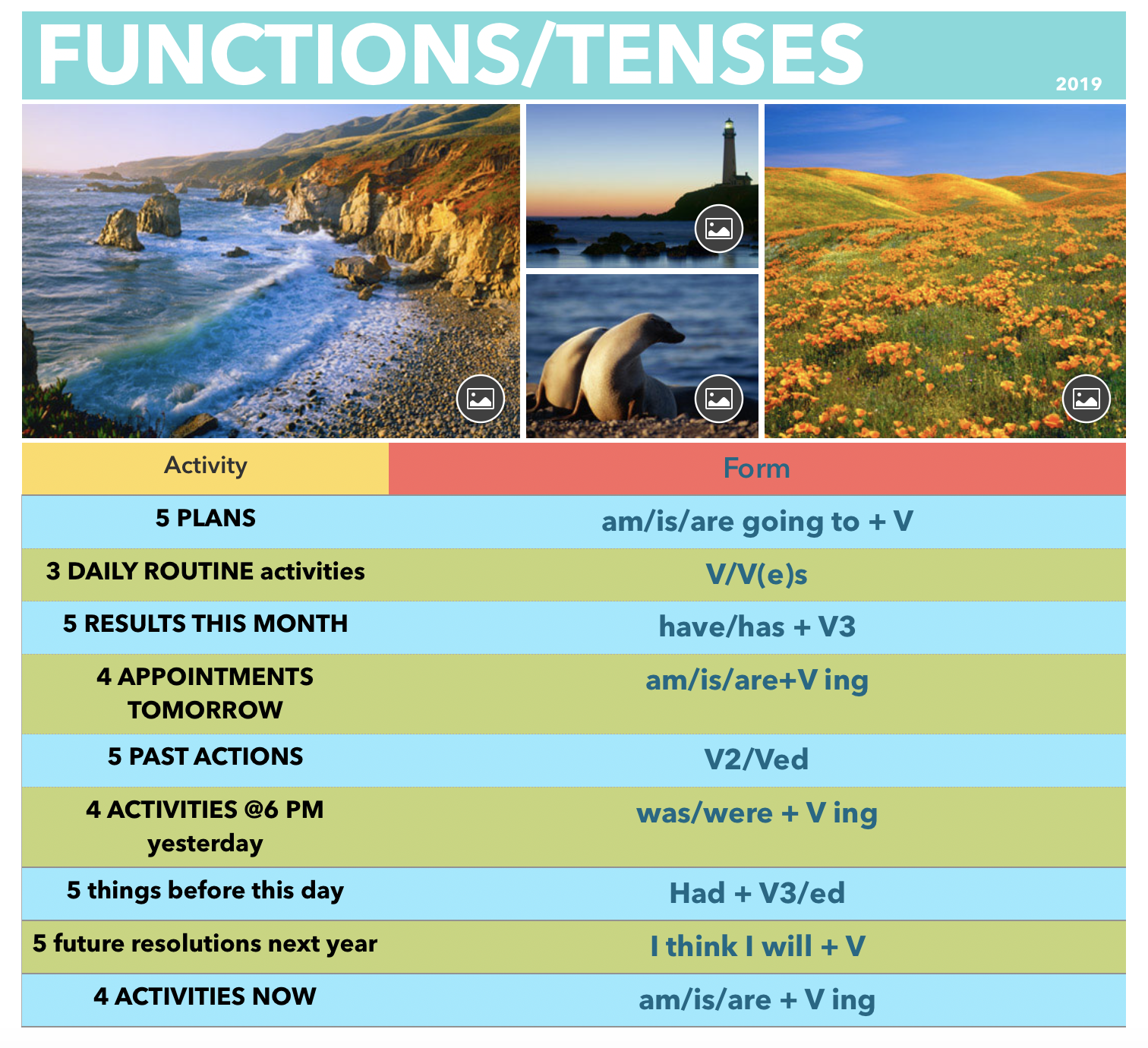
You can also give them the constructions from the previous lesson to refresh prior knowledge:



Wants to be up-to-date
Use 1-minute news or One-Minute Read to let the conversation flow and help your students tune to the lesson (Intermediate-Advanced)
Lacks creativity
Vocab recycling is my biggest concern, moreover, if we talk about advanced learners as it’s very challenging for them to move from one stage to another quickly, hence at the beginning of the lesson, I can use our slide What I can do to recycle words and boost creativity:
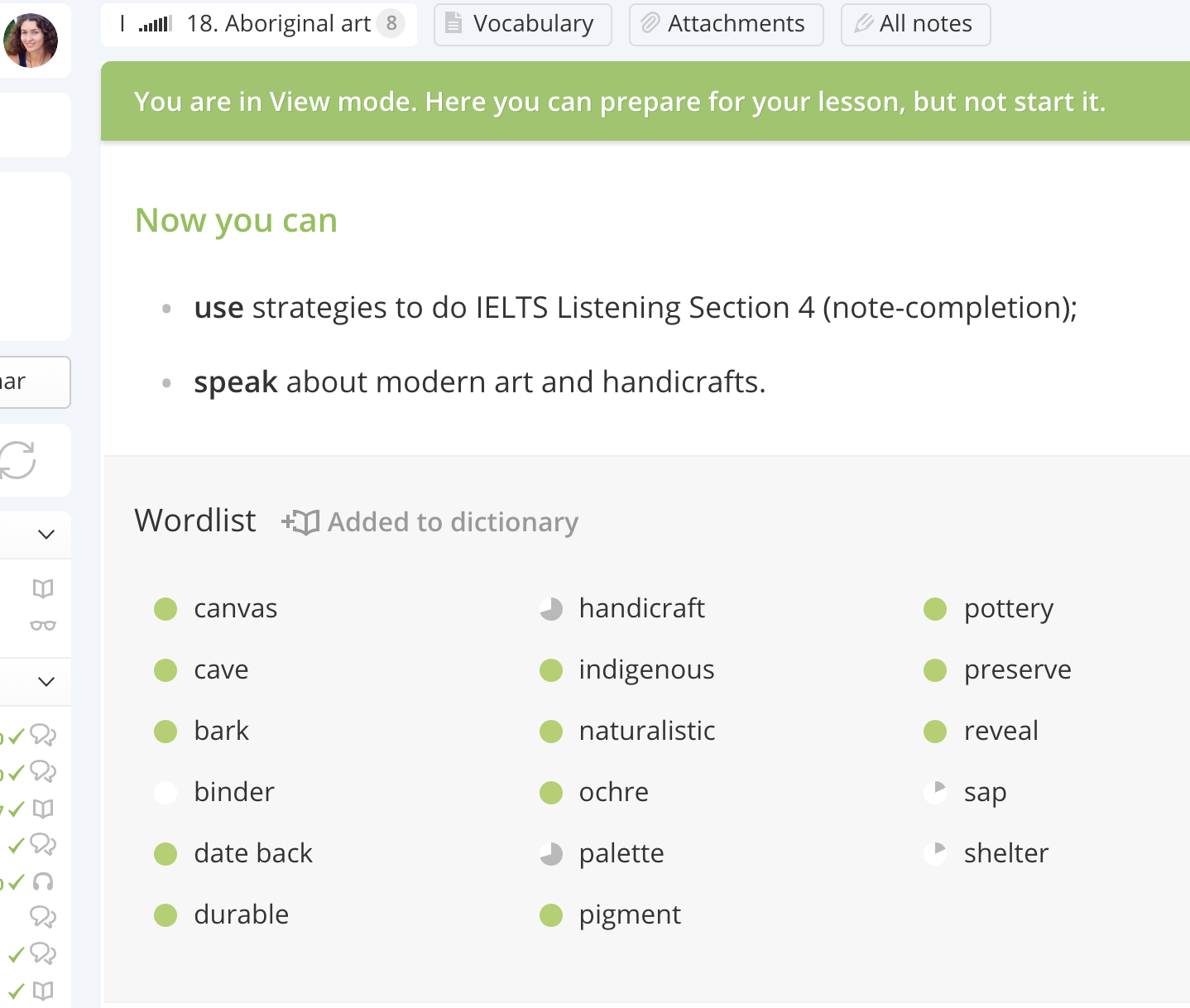
If you don’t work for Skyeng and use other textbooks, they do also contain infoboxes with Wordlist that you can use. How? It depends what you plan to practice: ask your student
1) to create all types of questions with these words;
2) to make a funny/sad/silly short story based on the target vocabulary; 3) to give definitions to each word (usual/ sarcastic/ humorous);
It will serve as a nice warm-up, revision, and tuning-to-a-new-lesson activity.
A bit of Poetry
For poetic souls and not only, for those who aim at enriching their vocabulary in no time.
To enrich my students with beautiful and advanced vocabulary, I sometimes select some literary pieces:
— limericks to have fun or PUN on words:)
— tongue twisters to polish pronunciation
— various poems to revise words on the topic and have a short philosophical discussion
— brainyquote.com to warm up and lead in the topic
Idioms and collocations

Give your advanced learner 5-6 idioms to ponder on or create a list and upload it for them to discuss. Idioms will enable their contextual guess.
Categories
Categories games are engaging. For example, if you study the Business English topic connected with Advertising, you can boost things:

Task-oriented
You can ask your IELTS/TOEFL/USE/MUSE-oriented student to comment on the exam structure just to recycle the skeleton of the exam:
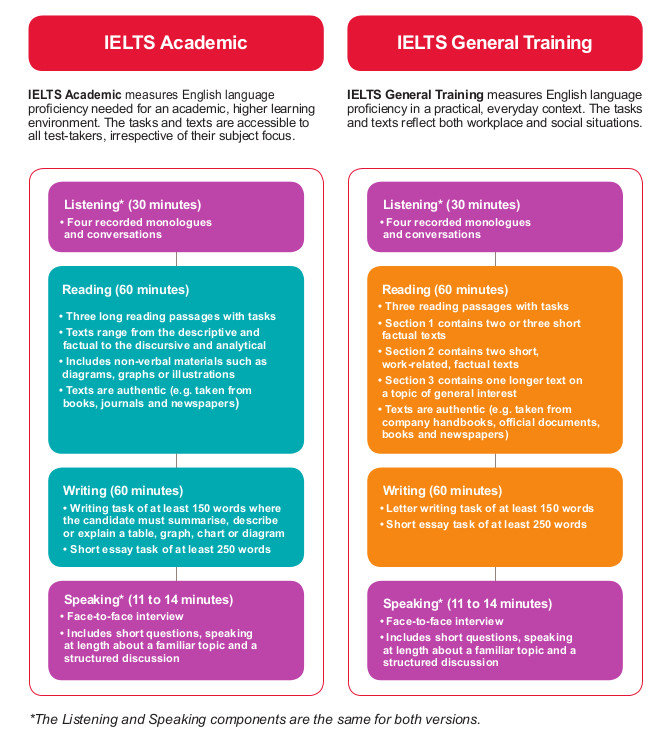
Anyway, it doesn’t matter what you choose — I am sure it’ll be beneficial to your students.
We are all wired to play and be playful. Evolution psychology has proved that playing is a survival mechanism.
Edward Norbeck has said: “It seems the more advanced a species is on the evolutionary scale, the more frequent and diverse are its play activities.”
Having fun and humour in class is vital. They affect the chemistry of stress. Humour allows us to be natural, feel great and bond with each other. We live in interesting times, wouldn’t it be awesome to use some warm-ups in your classroom and open the doorways for learning to happen?
I have collected 60 warm-up activities for your English class or any class that will take your teaching practices to the next level. Go over the 60 warm-ups and share what worked for your students in the comment section below.
Also, find the pdf version of the 60 warm-up activities for English class below!
Enjoy
1 Space walk

This game is invaluable for the development of group and spatial awareness.
- “Find a space to stand in. When I clap my hands, walk
quietly around the room in any direction. Try to fill the space – move into empty areas. Keep changing direction. Try not to come into contact with other people. Now Freeze!” Check that everyone stands absolutely still, freezing every muscle. Ask them to notice areas of the room which are emptier. Repeat the exercise with any of the following variations:
- Avoid eye contact.
- Make eye contact with every person you pass.
- Every now and again, shake hands with someone and move on.
- Find a new way of moving in the space. And another way, low down. And another, high up.
- On a signal, move in slow motion, then normal, then fast, all the time being aware of other people.
- Imagine you are moving through thick snow, over ice, under water, on hot sand, through an art gallery…
- Freeze!
- Play Noses
- Make physical contact with one other person and continue moving together in the space. Find new ways of moving together.
- Move apart from your partner but maintain eye contact, without bumping into anyone else.
- And freeze again. Notice exactly where you are in relation to others around you. Run and touch each of the four walls and return to exactly the same place without bumping into anyone.
2 Splat!
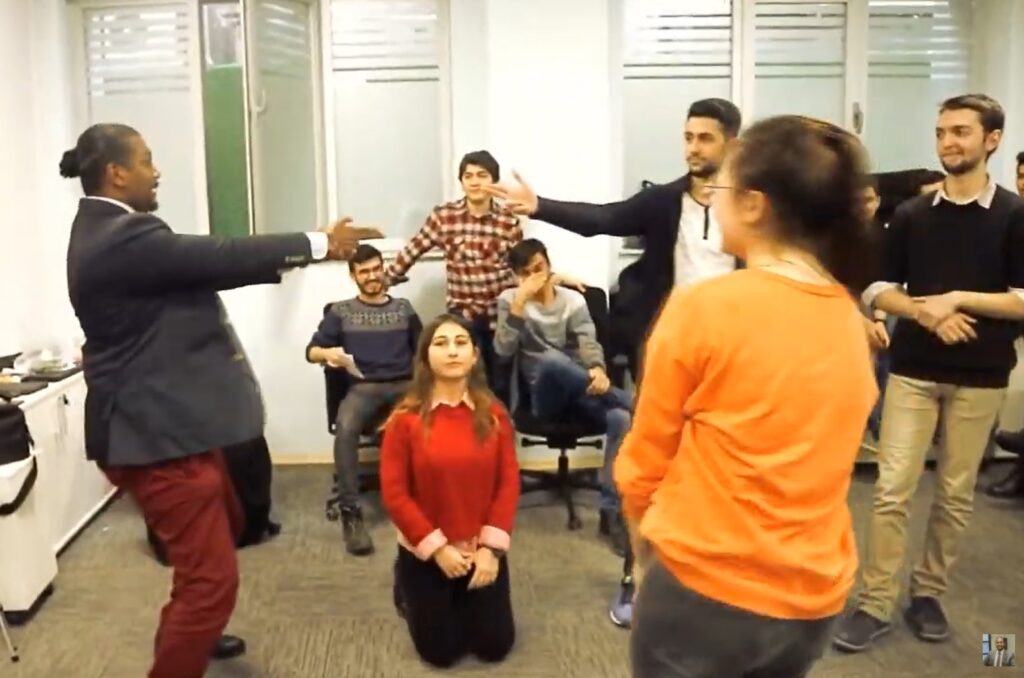
Here is a fun game for all. The group stands in a circle, facing the middle, with one person in the centre of the circle. The person in the middle then spins around, and points to a person at random, shouting SPLAT! That person must then duck down, and the two people either side must point at each other and shout SPLAT! If the first person doesn’t duck in time, they get “SPLATTED” and are out. If they do, the last person to say SPLAT on either side is out. Quite confusing at first, but good fun once you get the gang of it!!!
3 Plus one, two, three
The first student says “Yesterday I went to the store and I bought [something].” The next person adds to the first by saying “Yesterday I went to the store and I bought [something] and [something else]. Keep it simple for the lower levels. For higher levels any student can add up to three individual items at a time.
4 A + B = C
Students are given two letters of the alphabet and they must come up with words that include both of those letters. If the letters were “l” and “l” for example, the student would say “T” plus “L” =…” and then finish with a word like “towel”. The next person then has to do the same in a short amount of time. Keep going around the class until someone stumbles. The letters can be used in order or reversed, and the word can be any length, but must be one single word. Words cannot be said twice in one game.
5 Birthday Game
First, Have the group stand and line up in a straight line. Then, after they are in line, tell them to re-arrange the line so that they are in line by their birthday. January 1 on one end and December 31 at the other end. The catch is that they must do all this without talking or writing anything down.
6 Map Game

Hang a large map of the world. Give everyone a pushpin. As they enter, they pin the location of their birth on the map.
7 Toilet Paper Game

Pass around a roll of toilet paper to the group and ask them to take what they need. No further explanation.
When done. Tell the group that as they go around the room, each person must tell a fact or something about themselves for each square of TP they took.
8 Paper Airplane Game

Everyone makes a paper airplane and writes their name, something they like and dislike on it (You may also want to add additional questions). On cue, everyone throws their airplane around the room. If you find an airplane, pick it and keep throwing it for 1-2 minutes. At the end of that time, everyone must have one paper airplane. This is the person they must find and introduce to the group.
9 Yes, let’s!
Whole group game. One person starts with a suggested action – “Let’s play the piano”, for example. Everyone else shouts, “Yes, let’s!” and the whole group carries out the action with as much enthusiasm as possible. After a while someone else can suggest a new action – “Let’s be spies!” – “Yes, let’s!” The aim is for the whole group to fully commit to the activity. Try not to rush too quickly from one activity to the next – explore each one for a while. A good warm-up for impro work.
10 Twenty Questions
Here is an old favorite I play very often with my high school or university students . The students have to guess what thing the person is thinking of by asking him or her 20 yes/no questions. If no one guesses the answer after 20 tries, the answer is revealed. A “yes” answer earns the questioner another chance to ask, a “no” passes the asking on to the next player. Maybe your students are advanced enough to ask appropriate questions on their own, in my case to facilitate my weak ones I hand out a print I made with examples of questions. The first question on my print is, “Are you animal?/vegetable?/mineral?. Then below that I have written three categories of questions: animal, vegetable and mineral. Under the animal heading my first question is “Are you human?” Then I have written questions like, “Are you famous?” “Are you in this school?” “Are you a man/woman?” “Are you Japanese?” In case the animal is not human I have, “Can I eat you?” “Can I ride you?” “Are you bigger than a _____?” etc. Under the vegetable heading I wrote questions like “Can I eat you?” “Are you delicious?” “Are you in Japan?” etc. And finally under the mineral headline I wrote, “Are you metal/ plastic/ stone/ wood?” “Are you [blue]?” “Do I have you?” “Are you in the classroom?” “Can I see you?” By using the print my students get a feel for asking questions in English and I have found many no longer need to refer to the paper. I hope you have good luck playing this great word game.
11 How do you like your neighbour?
Equipment: A circle of chairs for all involved except for one person.
One person stands in the middle of the circle of chairs and announces “I like my neighbour who”…. eg. …is wearing sneakers … has brown hair, etc. Everyone who fits the statement must move (run) to another chair. The object is for the person in the middle to find an empty chair. This is a lot of fun and can be played for a long time. Remember to use your imagination.
12 Boppity bop bop bop
Get the group to stand in a circle. Everyone remains standing and there is one person in the middle. The person in the middle will go to someone and point saying “zip” or “zap”. Zip means left and Zap means right. When the person in the middle says “Zip” the person to whom they are pointing must say the name of the person on their left before the person in the middle says “Boppity bop bop bop”. If the person who is in the circle cannot do this, then they change places with the person who is “it” in the middle. This activity is great with older kids (14-19yrs).
13 Baby! What time is it?!
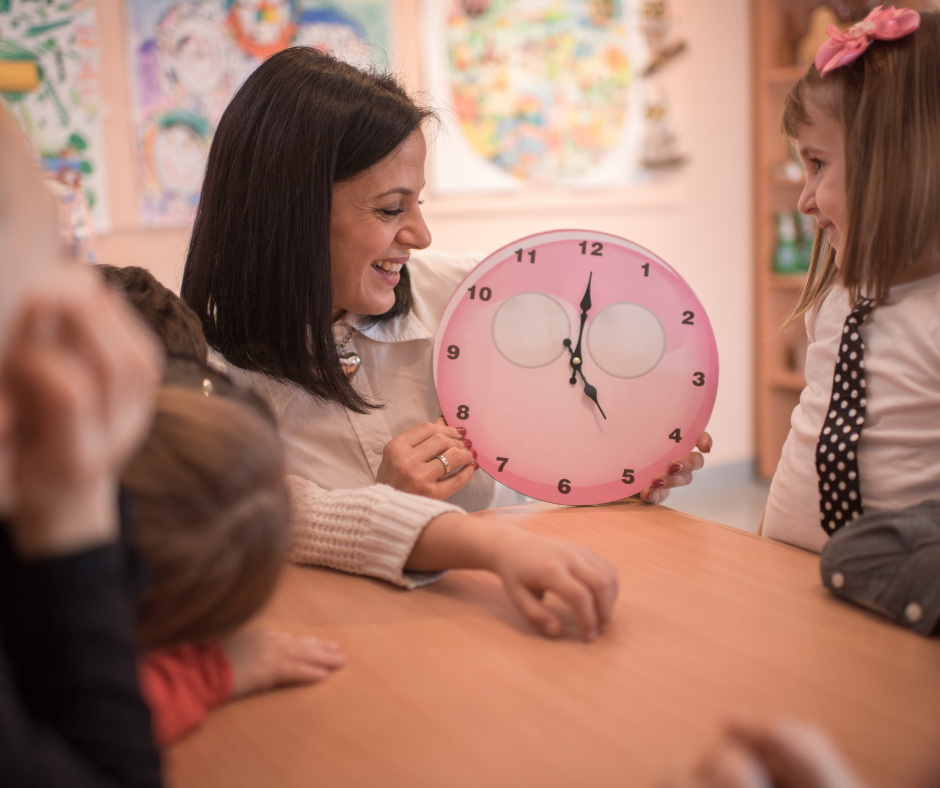
When teaching basic time-telling skills I devised this game. It’s good for beginners/children, but wears out after one or two uses, yet is quite effective and fun. Draw two blank clock faces on your white/black board and divide the class evenly (or even into thirds, etc.). Have one student from each group come to the board and have them race to draw the big and little hands properly when you tell them the time. This is a great way to install the concepts of quarter to and after, half past, five of, almost, on-the-dot, straight up, noon/midnight etc. Prizes aren’t necessary if you can drum some team spirit, but chocolate never hurts for the winners.
14 The Shoe Game

When entering, everyone must take off one shoe and leave it in a pile at the door. They keep the other shoe on. After everyone is in. The host will distribute the shoes to people not wearing the same shoe. When instructed, everyone must find the mix and find the person who belongs to the shoe and get some info about them. They then introduce their new friend to the group.
15 The Artist Game
Give everyone a piece of paper and a pencil. In 5 minutes they must draw a picture that conveys who they are with out writing any words or numbers. At the end of 5 minutes the host collects the pictures. Show the pictures to the group one at a time and have them try to guess who drew it. After this allow each of the artists to introduce themselves and explain how their work clearly conveys who they are.
16 Three in Common Game
Break the group into 3’s. Their objective is for each group to find 3 things they have in common. But not normal things like age, sex or hair color. It must be three uncommon things. After letting the groups converse for 10 – 15 minutes, they (as a group) must tell the rest of the groups the 3 things they have in common.
17 Group juggle
There are several variations of this game. A ball is thrown across the circle from one person to the next. Once the action is going smoothly, a second ball is introduced, perhaps of a different size or colour. This one could be bounced or thrown across the circle. You can continue adding as many balls as the group can manage. It is important to maintain focus and to stop and start again if the game gets out of control. As ever, communication is essential – just as it is between actors on stage. Make sure you have eye contact before you throw. Group members should aim to take responsibility for each another.
- In one variation a single ball is thrown so that everyone catches it once. Then the group tries to repeat exactly the same pattern – but faster and faster – without making a mistake. Add in more balls one by one, to be thrown in the same order.
- Try also having one person stand in the middle of the circle. The job of the people around the circle is to throw the ball to that person, who must then throw it to somebody else. No-one should ever throw the ball until they know the person in the middle is ready. Again, more balls can be introduced. • For adults – if somebody drops the ball, they say “Oh, balls”. The game starts again when everybody is focused. This takes the edge off making a mistake.
• An amusing twist on the game is to use all sorts of objects instead of, or as well as balls – rubber chickens, cuddly toys and beanie babies.
18 Pantomime

The actors will work in groups of 4-6 and are instructed to pantomime a single general activity (examples: Playing different sports at school, performing with an orchestra, circus acts, hospital work, etc.) To communicate the idea of a GENERAL activity, each actor must pantomime a SPECIFIC one For example: “Office works”
One actor mimes being a typist, another delivers the mail, another is a “boss” at a desk (perhaps on the phone), a client visits the office to see the boss, etc.
The audience then guesses the general activity and then talks about the specific ones. Make sure the actors understand they cannot speak – only mime with their bodies, facial expressions, etc.
19 Bean Bag

This exercise demonstrates to the children how important it is to project their voices. Place three bean bags in front of a row of children. One about 10 feet away from them – the second about 20 feet away, the third about 35-40 feet away (this can obviously be changed to suit the physical environment of the class).
- Ask each child to look directly at the first bean bag, say their name and the name of their favorite animal.
- Instruct him to say the exact same things to the second bean bag
- Would he speak with the same volume? Of course not – the “person” is further away
- When asked to address the third bean bag, he obviously should be projecting his voice as loud as he can. After all the class has addressed the bean bags, let them know were really acting in a play just then – reaching the first three rows, the middle rows, and the back rows of the theatre!
20 Clap the ball
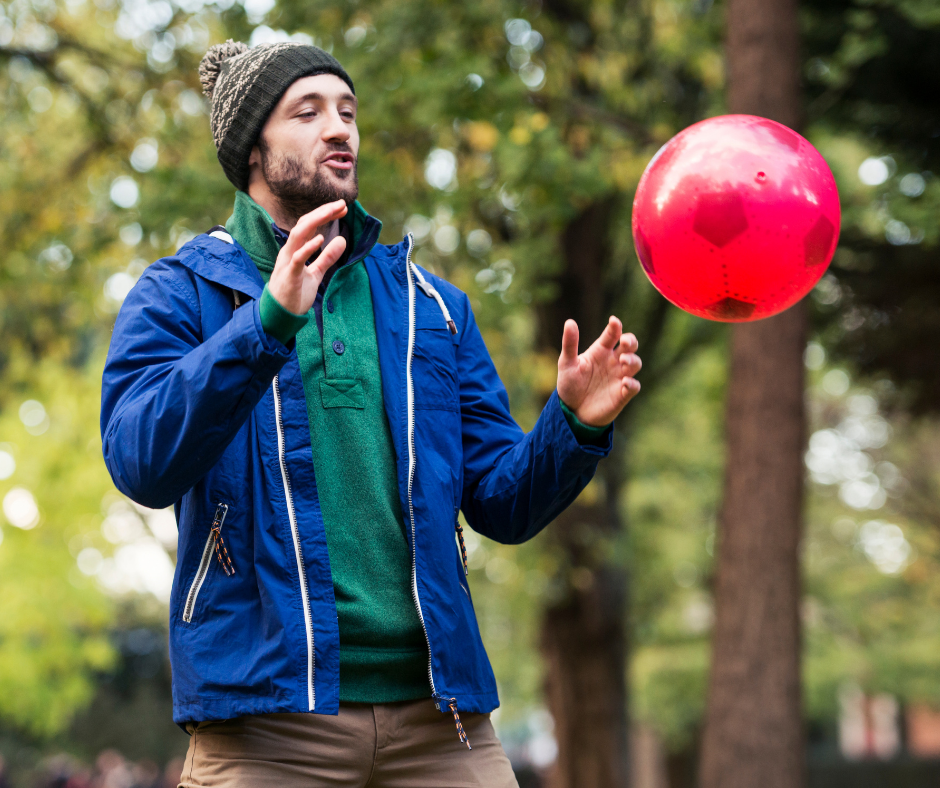
Begin by throwing a tennis ball or beanbag to each other across a circle. The person throwing the ball has responsibility for whether the other person catches it – so make sure that people are clear about whom they are throwing to. Once this is working well, introduce the idea that everyone must clap their hands in unison once, while the ball is in the air. Complicity between group members is essential. If this goes well, the game continues so that each time the ball is thrown, the group try to clap together one extra time. So the first time it is thrown, everyone claps once, the second time twice, and so on. You will probably get up to seven or eight and then it will start to get more difficult. Once it breaks down, start again from one. This is an effective way of encouraging concentration and awareness.
21 Dream Vacation Game

Ask participants to introduce themselves and describe details of the ideal, perfect dream vacation.
22 Favorite T-Shirt Game

Ask attendees to bring (not wear) their favorite T-shirt to the meeting. Once all participants have arrived, ask each person to show the shirt to the group and explain how the T-shirt best resembles their personality.
23 Famous People/Cities Game

As each participant arrives, tape a 3 x 5 index card on their back with the name of a famous person or city. They must circulate in the room and ask questions that can ONLY be answered with a YES or NO to identify clues that will help them find out the name of the person or city on their index card. EXAMPLES: Paris, Madonna, Santa Claus, John Wayne, Casablanca.
24 Favorite Animal Game

As the guests arrive, and before you write their names on a name card, ask them to tell you their favorite animal and three adjectives to describe the animal. As they tell you, write the three adjectives on a name tag BEFORE their name (omit the name of the animal). Ask them to mingle with the crowd, sharing why these adjectives best describe their own personality. EXAMPLES: Loyal, cuddly, playful Dan.
25 Creative Name Tags

Give everyone 15 minutes to make their own name tag-they can list hobbies, draw a picture, give a self[1]profile, etc.
26 Categories
Students are given five categories (animals, fruits & vegetables, person’s name, work-related words, countries) and one letter of the alphabet (s, b, w, r, and m). In a limited period of time, they must come up with as many examples of each category that start with that letter. When the first letter is done, check everyone’s answers. If the student has a word that no one else has, that student gets a point. Then move on to the next letter.
27 Here Pussy Pussy

Get the group to sit in a circle. Put a random number in a bowl or something of that sort. Get each individual to pick a number. The one with number 1 goes in the middle of the circle, and gets down on his/her all fours and acts like a cat. The person with the number 2 then has to tap the person on the head and say “here pussy pussy” without smiling or laughing. It’s up to the group to decide whether the person should go into the middle. I have played this game a few times with various groups. It is always a good laugh especially with a group just starting up.
28 Who is it?

A chosen “guesser” goes out room. A leader is then picked from the group. Whatever the leader does the group must copy. When the “guesser” enters, they must try and see who the leader is by trying to work out who is starting the new actions off (tell the group not to all look at the leader as it makes it harder). This is a really fun game and is good to keep a small group occupied for short time.
29 Cries of animals

The game is filled with laughter and fun with the intention of forming the participants into groups of 4 – 10.
Preparation: Before one could conduct this game, he or she needs to write the names of animals (cow, cat, pig, etc.) on to pieces of paper or card. Once the group is ready to play, distribute these written slips of paper to all. Let the participants not show their slip to another person as this needs to be top secret. Then tell the group to make the sound of the animal that they have on the slip and form a family of the same animal (in one corner of the room) The group carefully listens to the similar sounds from the others. In this way, it would be easy to form the participants into groups.
30 Circle of Friends Game
This is a great greeting and departure for a large group who will be attending a seminar for more than one day together and the chances of meeting everyone in the room is almost impossible. Form two large circles (or simply form two lines side by side), one inside the other and have the people in the inside circle face the people in the outside circle. Ask the circles to take one step in the opposite directions, allowing them to meet each new person as the circle continues to move very slowly. If lines are formed, they simply keep the line moving very slowly, as they introduce themselves.
31 Marooned Game

You are marooned on a island. What five (you can use a different number, such as seven, depending upon the size of each team) items would you have brought with you if you knew there was a chance that you might be stranded. Note that they are only allowed five items per team, not per person. You can have them write their items on a flip chart and discuss and defend their choices with the whole group. This activity helps them to learn about other’s values and problem solving styles and promotes teamwork.
32 The Interview Game

Break the group into two person teams (have them pick a partner that they know the least about). Have them interview each other for about twenty minutes (You can also prepare questions ahead of time or provide general guidelines for the interview). They need to learn about what each other likes about their job, past jobs, family life, hobbies, favorite sport, etc. After the interviews, reassemble the group and have each team introduce their team member to the group. This exercise helps them to learn about each other.
33 Story Time Game

The facilitator starts a story by saying a sentence. It then goes in a circle, each person adding a sentence onto the story-after repeating each sentence that’s already been added.
34 Ball Toss Game

This is a semi-review and wake-up exercise when covering material that requires heavy concentration. Have everyone stand up and form a resemblance of a circle. It does not have to be perfect, but they should all be facing in, looking at each other. Toss a nerf ball or bean bag to a person and have tell what they thought was the most important learning concept was. They then toss the ball to someone and that person explains what they thought was the most important concept. Continue the exercise until everyone has caught the ball at least once and explained an important concept of the material just covered.
35 Positive Reinforcement Cards Game
Whenever a participant arrives to class on time from breaks, lunch, etc. give them one playing card. You can also hand out cards to people who volunteer for activities, are helpful, answers a difficult question, etc. At the end of the day, play one hand of poker. Give a small prize to the best hand (you can also pick the top two or three hands if you want to give away more prizes). Note that the more cards a person has, the better the chance of winning.
36 Human Bingo Game

Before the meeting, make a bingo matrix and at the top of each square put something that someone in the group might have done-for example, voted for Ross Perot, served in the Peace Corps, etc. Everyone gets a copy and is asked to circulate, getting other group members to sign one square that is true of them. The first person to get “bingo” wins the prize (a candy bar or some other small thing).
37 Sound and action
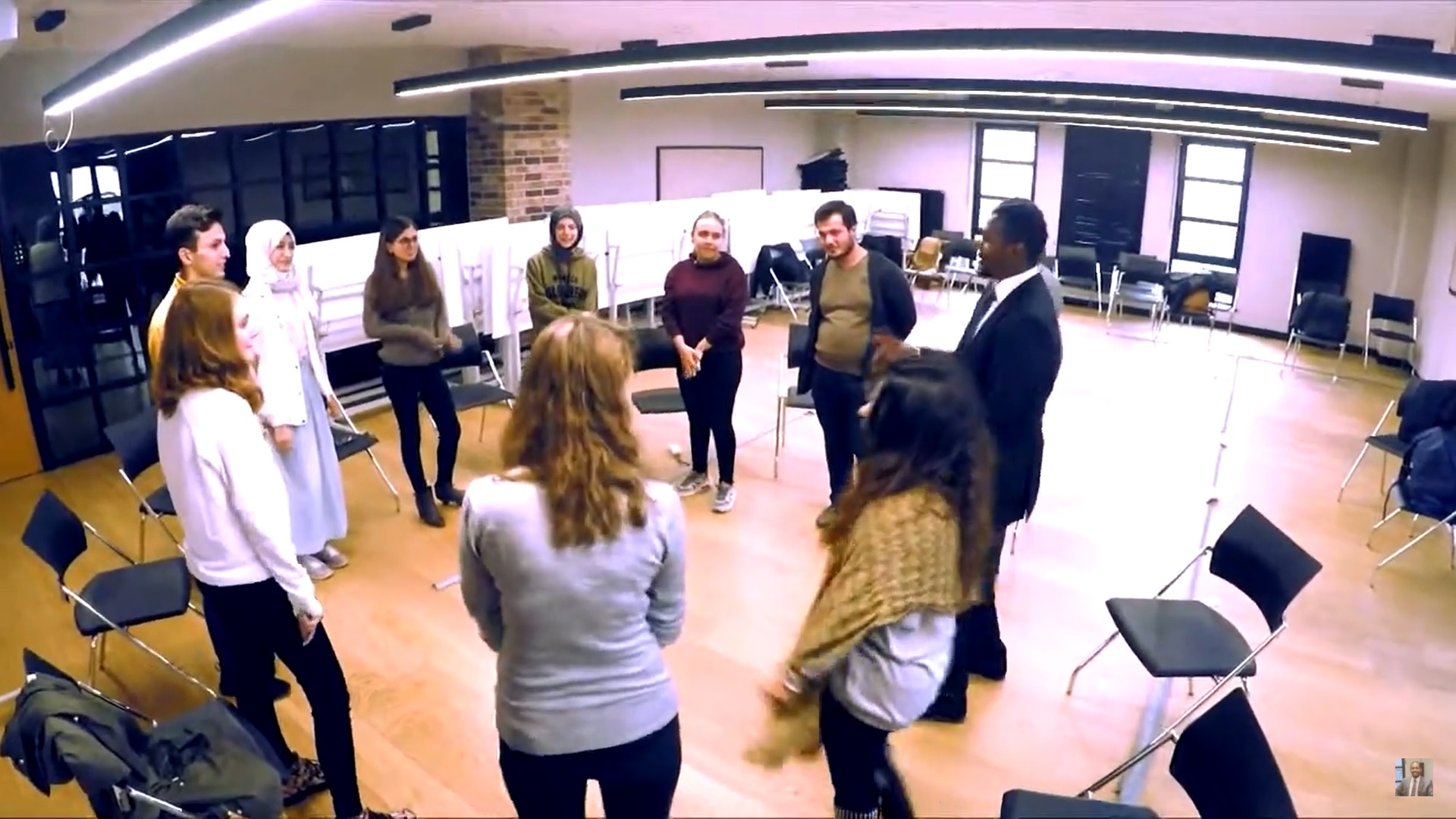
In a circle, the first person makes any kind of simultaneous sound and action. Following this, everybody else tries to copy the sound and movement as exactly as possible, at the same time. The next person along makes a new sound and action, which everybody copies. It’s best if you try to come up with the sound and action on the spur of the moment rather than preplanning it. The game should move quite quickly. This is a fun warm-up, and it is usually possible to go around the circle a couple of times without losing interest. It is liberating to see everyone else copy your own sound and action. Encourage the group to explore different ways of moving, including different heights.
- One variation is that the first person makes their sound and action to their neighbour, who copies it, turns to the next person and makes a completely different sound and action. This continues round the group.
- A concentration game can be played in this way: Go round the circle once with everybody making up his or her own unique sound and action. Then one person makes her own sound and action once, followed by the sound and action made by any other person. That person makes his or her sound and action followed by somebody else’s – and so on. See how long you can keep it going.
- An ideal follow-up activity would be to use the sounds and action which have been created to make an abstract machine in the centre of the circle, with everybody finding a way to add in their own repeating sound and action in relation to the others. At the end you could decide what kind of machine it was.
38 Out on the Town Game
If you have a two-day meeting and need a quick warm-up for day two, ask everyone to pantomime something they did the night before. Individuals or groups can act out a movie they went to, describe a meal they ate, or recreate a scene witnessed at a cafe….
39 Lucky Penny Game

Each person takes a penny or other coin out of their pocket and looks at the date. When it’s their turn, they tell the year that’s on their coin and recall something spectacular that happened that year.
40 Straw & Paperclip Game

Give each group a box of straws not flexible straws) and a box of paperclips. Check that the paperclips can fit snuggly into the end of the straws. Give each group a task (you can use the same one for each group if you want) and let them go. Sample tasks: Build the structure as a group. tallest strongest longest most creative most functional etc. Debriefing included describing teamwork and situational leadership skills used as well as how different models are needed to accomplish different tasks.
41 Four Facts Game
Each person writes down four facts about themselves, one of which is a lie. Each person takes turns reading their list aloud and the rest of the team writes down the one they think is the lie. When all are done reading the lists aloud, the first person reads their list again and identifies the lie. The team sees how well they did.
42 Miscellaneous Memory
Students practice verbs. Give students a sentence written on a piece of paper, such as “He watched TV every afternoon.”
Provide one students with a word that changes the time of the action, such as “now”.
. Ask the students to rewrite the sentence accordingly and produce
“He’s watching TV now.”
Give the next student another word, such as “I” instead of “He” so the pupil says “I’m watching TV.”
Continue until one student makes a mistake or until you’ve gone round the whole class.
43 Giving presents

A fast-moving game in which ideas are generated very quickly. In pairs, mime giving and receiving presents. The person giving the present must not decide what it is. The recipient should mime opening the present and only then say what it is. Don’t pre-plan, just decide on the spur of the moment. Whatever it is, be really delighted and grateful – it is just what you have always wanted! Then quickly swap over and give a present back. Keep swapping over for a few minutes.
- Afterwards it is fun to go around the circle and find out some of the presents people received.
- Try playing an even faster version where the gift is not wrapped so that the recipient immediately says what it is and thanks the giver.
44 The Clapping Game

A sure-fire energiser that will raise the energy of your group, and make them laugh.
Standing in front of a group, one person passes their hands in front of themselves in a repeated back and forth motion asking everyone to clap only when his or her hands pass.
You need one person to stand in front of your group. Maybe that’s
you? Explain that you want everyone to watch carefully as you move
your hands back and forth in a particular pattern. Perhaps alternating left and right, or up and down, it doesn’t matter much. Just make sure that at some point your hands cross during the journey.
The fun part is that you ask your group to clap every time they see your hands cross. It’s at this point, I rediscover how much I love this game, energiser, diversion, call it what you like. The intense focus
and concentration on people’s faces is priceless. So you start passing, slow at first, then in rapid succession. And then, I suggest, you get tricky. Make out like your hands are about to cross, but they don’t. Guaranteed, money in the bank, this lark will cause your group to clap, and then quickly realising their mistake, laugh out loud. You need only present this exercise for minute or so, and it will produce the desired effect. Your group will now be bubbling with more energy, and there will be smiles and laughter aplenty.
VARIATION
Structured as an elimination game, same rules apply. If someone makes a ‘mistake,’ for example, a person claps when they shouldn’t, or is late, etc, they are asked to step aside, sit down or whatever and enjoy the continuing action. Keep going until one person remains, and give them a round of applause!
45 Pass the sound
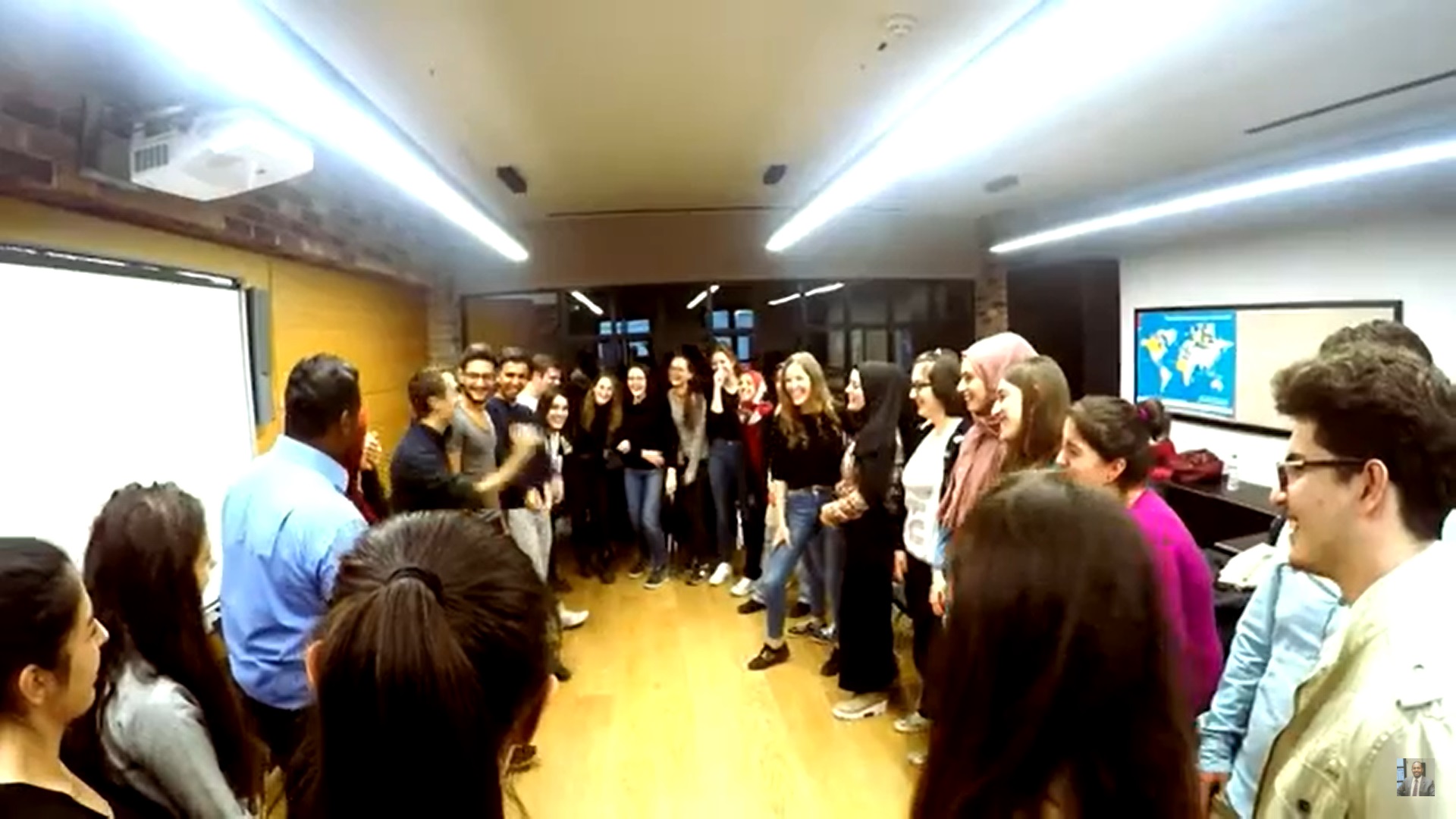
All the students stand in a circle. One person chooses a short, sharp sound, then putting his/her hands together points to the person next to them and makes the sound. The next person puts their hands together, points to the person next to them and makes the sound.
Pass the sound around the whole circle. Then tell the students then can change the direction of the sound by pointing to someone across the circle or sending the sound back to the person who gave it to them. This game needs to be played at a fast speed.
46 What are you doing?
Stand in a circle. The first person (A) starts miming an activity, such as eating an apple. The person to their left (B) says “What are you doing?”. A keeps miming and at the same time says the name of a different activity. For example, if A was miming eating an apple, they could say “playing the piano”. B then starts playing a piano. A stops their mime. Now the third person (C) asks B , “What are you doing?”. B keeps playing the piano and names a different activity, which C must mime. And so it goes on.
There should be no repetition and no similar activities. For example if you are miming climbing a ladder you cannot say, “climbing the stairs”. Equally you should not name an activity that looks like the one you are actually doing. For example, if you are cleaning a window you cannot say “waving good-bye” – because it looks very similar!
47 Zip zap boing

Concentration and warm-up game in a circle. A sport played with an imaginary frisbee. One person starts by passing the frisbee to their right or left, saying “zip!”. The next person catches it and passes it on with a “zip!” When everybody has had a go, “boing!” is introduced. Anyone may now change the direction of travel by raising their hands as though deflecting the “frisbee” and saying “boing!”. It is then passed back the other way with a “zip!” Finally, “zap!” is introduced. Here, anyone may pass the “frisbee” across the circle with a “zap!” Eye contact is essential throughout. People may “boing!” back and forth to one another (as long as they don’t go on for too long). Make sure people don’t say “zip” when they mean “zap”!
48 A to Z Freeze Game

Ask participants to recite the alphabet in unison. Let them go on for a while until you yodel “Stop!” At that point, identify the letter they stopped on and ask everyone to share something they are looking forward to at school that begins with that letter. For example, if the letter is “R,” they might say “ravioli in the dining hall” or “rooming with someone cool.” Once everyone has shared, have them recite the alphabet again. Stop them on a different letter and ask participants to share a personality trait they possess that begins with begins with that letter. If the letter is “D” they might say things like “diligence” or “doofiness.” Come up with different questions to ask for each letter and repeat the process.
49 Reception Line Game
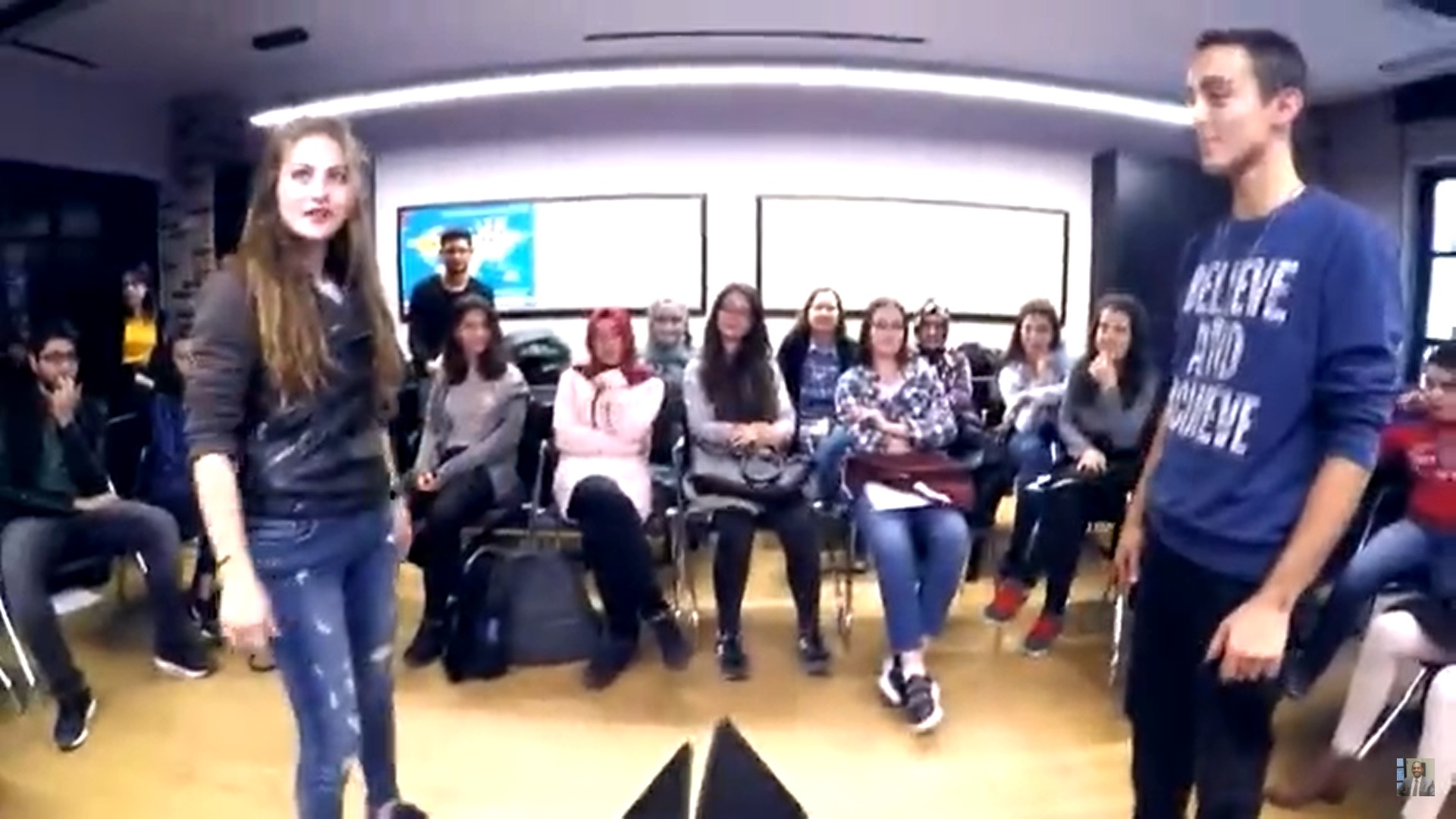
Divide everyone into 2 groups. Have them stand facing each other. Each person talks to the person across from them until signaled (flash lights). At signal, person at end of one line moves to other end. Consequently everyone has a new person to talk to.
50 Autograph Sheets Game
Prepare a sheet listing traits or facts about people with a line for them to sign their name next to the trait if it applies to them (i.e.: someone who wears contacts, someone who has been to Europe, etc.). People then mingle around the room with their sheets seeking to find people who are eligible to sign their sheets. A person can only sign once on any sheet. The process may also be reversed by having people seek out the autograph of people to which they think the category applies (i.e.: someone who looks like they enjoy the outdoors, someone who is from the east, etc.)
51 Traffic lights

A physical warm-up game. The leader calls out traffic light colours in any order, trying to catch people out.
- “Green” – Walk/run around the space.
- “Amber” – Stand on one leg without over-balancing.
- “Red” – Stop still – or lie down on the ground!
52 Puzzles Game

Give participants a blank piece of puzzle (cut up a sheet of index card stock). Each person writes on the piece one skill which they contribute to the group. The puzzle is then assembled to show that everyone contributes to the whole.
53 The Hidden Treasure

Students practice prepositional phrases.
Tell one student to turn his back to the class or to close his eyes. Hide a small object.
Tell the student to start asking questions that include prepositions in order to find out where the object has been placed. Remember not to allow sentences that don’t include prepositions. The game is over when the student finds the object.
54 Gotcha!

Never fails to produce raptures of laughter.
Standing in a circle with their index fingers pointing downward into their partners’ open palms, everyone tries to catch the juxta[1]positioned finger at the same time.
Ask your group to form a circle, facing inwards and standing side by side. Note, this next bit is best if you demonstrate as you explain it.
Holding your right hand out to your right hand side (about shoulder height) with your palm facing upwards, extend the index finger of your left hand, and place it into the open palm of the person on your left.
Look around, and you should all be inextricably linked. Now, on the command “GO!” – which works pretty well to start a game – everyone tries to catch the finger of the person on their right, that
which is pointing downward, touching the centre of their palm. Of course, jocularity prevails, because everyone is also trying to avoid being caught by the person on their left. I just love that bit. Ask people to shout out “GOTCHA!” when they catch a finger.
Now, you could try to move on, but I doubt you will want to. There are ample moments of humour here. Observe the way in which the palms of some people, which first started out as flat, are slowly
curling with each round. Or the proclivity of folks to not want to touch their finger tip on their neighbour’s palm, lest they get caught!! It’s all so funny.
My biggest Gotcha group? Two-hundred and fifty! Spectacular.
VARIATIONS
- Try this again several times, switching palms from the right to the left (to benefit our left-brained friends), i.e., the left palm is facing upwards, and a right index finger is extended.
- Cross your arms as you play, i.e., extend the right palm in front of your chest to point toward the person on your left, and place your left index finger into the waiting palm on your right.
- Try all variations with your palms upside-down, and index fingers pointing up.
- Regular set-up, but this time each person attempts to catch the finger sitting in their right palm with their left hand. Try it. Hilarious.
- Original set-up, add a further challenge. Instruct people to place their right foot directly above, but not touching the left toes of their right-hand side partner. On “GO,” you try to tag the foot of your partner, whilst trying to avoid being tagged and performing the usual finger and palm routine.
- Everything above, but groups of only two or three or whatever.
55 Kim’s game
Materials:
- 15-20 small objects and a cloth to cover them, paper and pencils
The teacher or trainer collects 15-20 small objects, eg, a pencil, a leaf, a rubber, a book, a paper clip, a stone, etc.
The teacher picks one object up at a time and holds them up and the
students call out what it is.
When the teacher has shown all the objects he/she cover them with a cloth.
The students must write down all the objects they can remember. The one who has remembered the most objects is the winner.
56 Human Knot Game

Divide into groups of 6-10 people. Each group forms a tight circle., standing and facing each other.
Everyone extends their hands into the circle and by intermingling their arms, grasps hands with other
members of the group. Instruct people to “ be sure that the two hands you are holding does not belong to the same person”. The groups’ goal: untie the knot which results. Member of the group physically climb over/ under/ through each other’s arms to untie the knot of bodies. Note: It’s RARE but it is possible for a knot to be unsolvable or end in two separate circles.
57 Keept it up – Keep it high

A fun warm-up game for re-energising people first thing in the morning or after lunch. You need a room with a high ceiling, or you could play it outside if it is not too windy. You also need a
ball – I like to use a children’s football. One person begins by hitting or throwing the ball as high into the air as possible. Members of the group try and stop the ball from hitting the ground by hitting it with any part of the body. Nobody is allowed to hit the ball twice in succession. At first, the game can appear to be quite difficult. After a while you can point out that the way to play the game is to work
together. Everybody must take responsibility for the ball remaining in the air. If someone is about to drop it, help them out. Try to be aware of who you are hitting the ball to next. Keep it high. It is good to set a target and then increase it – keep the ball in the air for twenty hits, then thirty, then fifty. The group will become quite motivated towards achieving the target (in fact it may be hard to stop them from playing!).
- Although you can use any part of the body, it is best to start off by just using the hands – using feet can lead to loss of control.
- If you are playing indoors you can allow people to bounce the ball off the wall (depending on light-fittings and windows!).
- A challenging variation is that every fifth hit should be with a part of the body that is not the hands.
- People will become more skilful the more they play the game.
58 Get in the News Game
Divide your group into teams of four or five persons each, and make sure each team has the necessary supplies–scissors, tape, pins, and plenty of old newspaper. You’ll also need a separate room or corner in which each team can work with privacy (and hilarity). Each group selects one person to be the model. After deciding what kind of costume to make, the team goes to work–cutting, crumpling, bunching, rolling, piecing, pinning, taping. After an appropriate amount of time, call everybody together for a costume show. (And don’t forget to recycle your newspaper when you’re finished!)
59 Stick in the mud

A children’s playground version of tag which can be played by children or fit adults as a warm-up. One person is chosen to be “it” and has to try and get everybody else stuck in the mud. The others have to avoid being caught by running away. If the person who is “it” manages to tag (touch) them, that person stays where they are with their arms outstretched and their legs wide apart. Anyone else who has not yet been caught can try to release others who are stuck in the mud. They do this by diving or crawling through their legs. If they manage to get through without being caught, then both people can run away. It is quite hard to catch everybody, but a good (and energetic) catcher can do it by guarding those who are already caught.
60 The Quiet Game

The instructor explains that this exercise will take self control. Members pair back to back. On the count of three, everyone must face their partner, look each other in the eyes, and then try to remain solemn and serious. No speaking! The first to smile or laugh must sit down. All who remain standing then take a new partner and the activity continues until only one person has not smiled or laughed. (Second round of playing can involve two teams competing to outlast each other.) If you get a pair at the end who are both keeping a straight face, the rest of the group can act ask hecklers to disrupt them.


